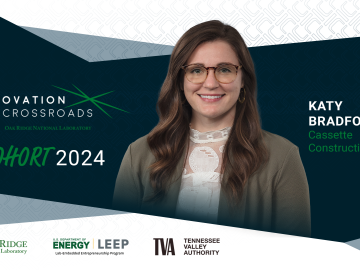
Filter News
Area of Research
- Advanced Manufacturing (1)
- Biological Systems (1)
- Biology and Environment (72)
- Biology and Soft Matter (1)
- Clean Energy (47)
- Climate and Environmental Systems (1)
- Electricity and Smart Grid (1)
- Fusion and Fission (4)
- Isotopes (1)
- Materials (31)
- Materials for Computing (7)
- National Security (11)
- Neutron Science (12)
- Nuclear Science and Technology (3)
- Quantum information Science (2)
- Supercomputing (35)
News Type
News Topics
- (-) Bioenergy (51)
- (-) Composites (8)
- (-) Environment (105)
- (-) Frontier (26)
- (-) Grid (26)
- (-) Materials Science (47)
- (-) Molten Salt (1)
- (-) Nanotechnology (16)
- (-) Partnerships (21)
- 3-D Printing/Advanced Manufacturing (43)
- Advanced Reactors (8)
- Artificial Intelligence (51)
- Big Data (29)
- Biology (60)
- Biomedical (31)
- Biotechnology (12)
- Buildings (23)
- Chemical Sciences (27)
- Clean Water (15)
- Climate Change (52)
- Computer Science (89)
- Coronavirus (17)
- Critical Materials (5)
- Cybersecurity (14)
- Decarbonization (47)
- Education (2)
- Emergency (2)
- Energy Storage (30)
- Exascale Computing (29)
- Fossil Energy (4)
- Fusion (31)
- High-Performance Computing (48)
- Hydropower (5)
- Isotopes (31)
- ITER (2)
- Machine Learning (23)
- Materials (44)
- Mathematics (7)
- Mercury (7)
- Microelectronics (3)
- Microscopy (20)
- National Security (46)
- Net Zero (8)
- Neutron Science (51)
- Nuclear Energy (56)
- Physics (31)
- Polymers (8)
- Quantum Computing (22)
- Quantum Science (32)
- Renewable Energy (1)
- Security (12)
- Simulation (33)
- Software (1)
- Space Exploration (12)
- Statistics (1)
- Summit (31)
- Sustainable Energy (48)
- Transformational Challenge Reactor (3)
- Transportation (27)
Media Contacts

Katy Bradford is on a mission to revolutionize the construction industry and is the founder of Cassette Construction, a company in the newest cohort of Innovation Crossroads, a DOE Lab-Embedded Entrepreneurship Program node at ORNL. As an Innovation Crossroads fellow, Bradford and her company will receive technical, financial and networking support to successfully advance the company’s products to the marketplace.

As a mechanical engineer in building envelope materials research at ORNL, Bryan Maldonado sees opportunities to apply his scientific expertise virtually everywhere he goes, from coast to coast. As an expert in understanding how complex systems operate, he’s using machine learning methods to control the process and ultimately optimize performance.

Nuclear physicists at the Department of Energy’s Oak Ridge National Laboratory recently used Frontier, the world’s most powerful supercomputer, to calculate the magnetic properties of calcium-48’s atomic nucleus.
Researchers at ORNL recently demonstrated an automated drone-inspection technology at EPB of Chattanooga that will allow utilities to more quickly and easily check remote power lines for malfunctions, catching problems before outages occur.

A study found that beaches with manmade fortifications recover more slowly from hurricanes than natural beaches, losing more sand and vegetation. The researchers used satellite images and light detection and ranging data, or LIDAR, to measure elevation changes and vegetation coverage. Changes in elevation showed how much sand was depleted during the storm and how much sand returned throughout the following year.

At ORNL, a group of scientists used neutron scattering techniques to investigate a relatively new functional material called a Weyl semimetal. These Weyl fermions move very quickly in a material and can carry electrical charge at room temperature. Scientists think that Weyl semimetals, if used in future electronics, could allow electricity to flow more efficiently and enable more energy-efficient computers and other electronic devices.

Five researchers at the Department of Energy’s Oak Ridge National Laboratory recently completed an eight-week pilot commercialization coaching program as part of Safari, a program funded by DOE’s Office of Technology Transitions, or OTT, Practices to Accelerate the Commercialization of Technologies, or PACT.

The world’s fastest supercomputer helped researchers simulate synthesizing a material harder and tougher than a diamond — or any other substance on Earth. The study used Frontier to predict the likeliest strategy to synthesize such a material, thought to exist so far only within the interiors of giant exoplanets, or planets beyond our solar system.

The National Security Sciences Directorate within the Department of Energy’s Oak Ridge National Laboratory has signed a memoranda of understanding with Jackson State University and with Tennessee Tech University. The MOUs detail ORNL’s intention to work with each university to enhance research and educational opportunities in nuclear science and engineering.

Two ORNL teams recently completed Cohort 18 of Energy I-Corps, an immersive two-month training program where the scientists define their technology’s value propositions, conduct stakeholder discovery interviews and develop viable market pathways.


